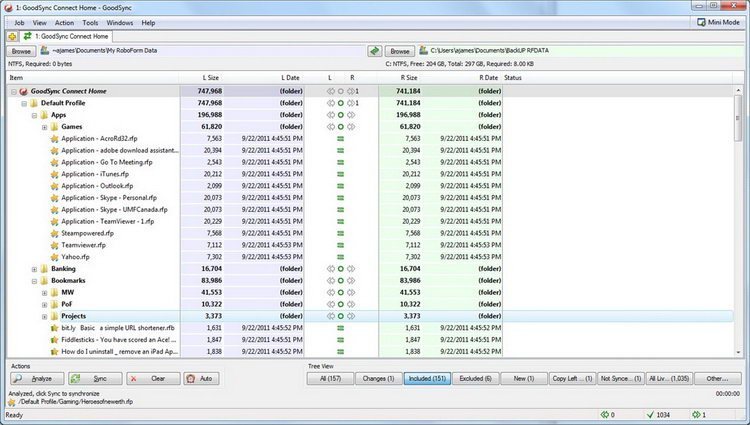
GoodSync ’s file synchronization technology uses the TCP/IP protocol as the underlying data transfer transport for file synchronization and file backup. GoodSync vs Resilio Connect for WAN Optimization Check out Resilio ’s file transfer speed calculator to see for yourself. This P2P approach also enables additional computers to participate in data transfers, distributing the load from a single computer to several.

This approach ensures data resilience on the wire: all computers participating in the file synchronization job receive data as fast as possible, allowing Connect to deliver the fastest file transfer and file synchronization speeds of any file sync or file sharing platform, outperforming GoodSync, rsync or any other tool. When comparing GoodSync to Resilio Connect, it’s important to know that Resilio Connect detects file changes and renames in real-time and hashes file changes across numerous computers, each of which travel independently between computers. Resilio sends less data over the network thanks to an optimized differential sync engine, built-in compression, and efficient recovery from failure. Resilio also makes efficient use of the network, minimizing the amount of data transferred. Combined with functionality to synchronize important files in any direction, Resilio Connect provides exceptionally fast, efficient, scalable, omni-directional file synchronization. Resilio Connect rapidly processes large data sets–including unlimited file sizes and up to many millions of files. For automation, real-time file synchronization simplifies managing jobs across many computers. In the Resilio Connect model, user friendly jobs are created for file distribution, consolidation, scripting, and synchronization each can be scheduled or automated. For example, with Resilio Connect you can synchronize 5 servers, backup data to several servers concurrently, or send updated files to as many file systems or cloud storage buckets as you need, all in parallel from several servers. In contrast to these Goodsync limitations, Resilio Connect offers universal file delivery, enabling omni-directional file transfer and file synchronization : jobs can include nearly any number of file systems (i.e., computers or “endpoints”) in a single job. Single point of failure in the event of an outage.Fixed resources on each computer: A fixed amount of CPU, memory, disk IO, and throughput could be limiting factors.Serialized data transfer between the two (2) computers.In short, the GoodSync architecture suffers from: On faster networks, the 2 computers may become a limiting factor to performance and availability using GoodSync. This holds true for a variety of scenarios: file synchronization to cloud storage (sometimes referred to as cloud sync ), server to server sync, and a variety of data transfer scenarios which could benefit from multi-directional file synchronization, such as file backup, file sharing and collaboration, and disaster recovery. There is no support for one-to-many, many-to-one, or many-to-many file synchronization scenarios. In the GoodSync model, file synchronization and file backup are constrained to one- and two-way data transfers between 2 computers. One fundamental difference is that Resilio Connect employs a peer-to-peer (P2P) architecture while GoodSync utilizes a traditional client-server model. There are several differences between Resilio Connect and GoodSync. This blog also addresses key differences between GoodSync and Resilio Connect, explaining both products’ architectures and functionality. This blog addresses those and other considerations in a GoodSync alternative.

For basic one- and two-way data transfers this approach may suffice but there are drawbacks (covered extensively in What’s the difference between peer to peer and client server? ).
GOODSYNC PRO SOFTWARE
GoodSync and other conventional file synchronization software programs (such as FreeFileSync, SyncThing, DirSync Pro, and Rsync, for example) utilize a point-to-point client-server architecture, where data transfer or online backup can be performed between two machines.
GOODSYNC PRO MAC
GoodSync runs on operating systems such as Microsoft Windows, Linux, Android, Apple Mac and iOS. The enterprise version of GoodSync offers a centralized management server to remotely configure and monitor jobs inside the enterprise. The backup software is used to copy changes in directories from one machine to another. The file synchronization job detects file changes in directories and synchronizes the changes between two machines. GoodSync, and programs similar to GoodSync, perform two primary job functions : file synchronization and file backup. GoodSync does a solid job of transferring data and synchronizing files between two computers. GoodSync, by Siber Systems, is a well-known file synchronization and backup software program built on a standard client-server architecture. GoodSync Alternative: Considerations and Overview


 0 kommentar(er)
0 kommentar(er)
